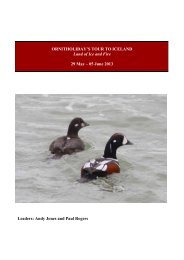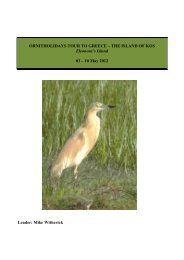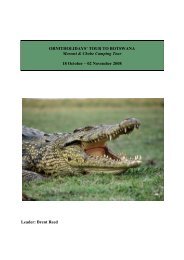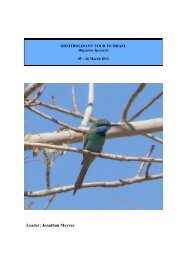Download 2014 Brochure (.pdf) - Ornitholidays
Download 2014 Brochure (.pdf) - Ornitholidays
Download 2014 Brochure (.pdf) - Ornitholidays
You also want an ePaper? Increase the reach of your titles
YUMPU automatically turns print PDFs into web optimized ePapers that Google loves.
B H U TA N<br />
Bhutan<br />
Birds & Buddhism<br />
Saturday 01 March – Friday 14 March <strong>2014</strong><br />
Leaders: Richard Coomber and local guides<br />
<strong>2014</strong> Cost £4,799 single room supplement £390<br />
I<br />
n <strong>2014</strong> we make our eleventh tour to Bhutan to visit the high altitude forests<br />
of the Bhutanese Himalayas – a land of rhododendron forests, stunning<br />
panoramas and friendly Buddhist culture. Bhutan is a small sparsely populated<br />
Himalayan kingdom, situated in the north-east of the Indian subcontinent, bordered to the north<br />
by the great Himalayan range and Tibet (Xizang). Most people of this country are dependent on subsistence agriculture; so this is a land little changed<br />
by the ravages of time: if Shangri-la exists, it is surely here. The Buddhist culture of the country broadens the experience of Bhutanese travel<br />
immensely; and although birding is naturally our main priority, we shall take time to appreciate this aspect. In particular we shall have several<br />
opportunities to look at the Dzongs, which blend the role of both fortress and monastery, playing a central part in Bhutanese life. They powerfully<br />
illustrate the overwhelming influence of Tibetan Buddhism in Bhutanese society. We shall see several of these enormous buildings, many of which are<br />
astonishing feats of construction.<br />
Thimpu<br />
Paro<br />
Punakha<br />
Wangdue<br />
BHUTAN<br />
Trongsa<br />
Birdwatching in Bhutan is a sublime experience. Towns are very small and frequently surrounded by untouched habitat. There is often little traffic and<br />
the roads provide excellent opportunities to walk, without difficulty, through what are surely the best-preserved forests anywhere in the Himalayas. In<br />
the valleys below, the wide rivers provide excellent wintering habitat for the Ibisbill - that strange and enigmatic wader from the Tibetan plateau. On<br />
the upland mires, Black-necked Cranes (the world's least-known crane species) may still be encountered, prior to their northward departure to their<br />
breeding grounds in Tibet. Other species we will seek include Wallcreeper, Crested Kingfisher, Great Barbet, and Yellow-billed Blue Magpie. We<br />
should come across many colourful minivets, fulvettas, minlas, yuhinas and sunbirds; and three species of forktails are possible. At this time of year<br />
the forests of Bhutan are world-renowned for the burst of colour created by flowering magnolia and numerous species of rhododendron. Naturally,<br />
this phenomenon will command our photographic attention!<br />
Bhutan has taken measures to preserve her forests and to try to develop a sustainable tourist industry. To this end it has restricted the number of<br />
tourists allowed to enter the country each year and it charges a high price for the privilege of entering. This is one of the factors that makes tours to<br />
Bhutan expensive, but it should ensure that future generations will be able to visit a country that has much to offer in the way of pristine landscapes,<br />
as well as being uncluttered by large numbers of tourists. Our tour has been designed to see the best of the country, with a minimum of long-distance<br />
travelling and removing the need to use tents. Bhutan hotel food is excellent and varied, catering for both western and Oriental palates. This proved<br />
to be an especially popular feature on our previous tours. Travel with Richard on this tour, designed to see Bhutan in the best possible way.<br />
ITINERARY<br />
Days 1 & 2<br />
We catch our scheduled flight from London, and<br />
we arrive in Delhi next day, in the early hours.<br />
After a restful morning, we will take an afternoon<br />
outing for birding in Delhi.<br />
Days 3 & 4<br />
We fly from Delhi to Paro in Bhutan. The Druk Air<br />
flight visits Kathmandu en route - if the weather is<br />
clear, there are stunning views of Chumulhari,<br />
Mount Everest, Kanchenjunga and other<br />
Himalayan peaks. We land in the picturesque<br />
Paro Valley at 2,150 metres. The valley, with its<br />
scattering of interesting half-timbered<br />
farmhouses and paddy fields, is dominated by<br />
the snow-clad peak of Cholhari. We transfer to<br />
Paro, where we stay for the next two nights. From<br />
our hotel we can see Paro Dzong, which<br />
dominates the view and is the centre of religious<br />
activity. We will have our first introduction to the<br />
Bhutanese birds, including the riverine<br />
Himalayan species such as White-capped and<br />
Plumbeous Redstarts, Brown Dipper and (we<br />
hope) our first Ibisbills. These unique waders<br />
migrate from their breeding grounds in the<br />
mountains surrounding the nearby Tibetan<br />
Plateau, to winter on the shingle banks of these<br />
wide rivers at lower altitudes. We will drive along<br />
the Paro Chu River towards Drukyel Dzong (now<br />
in ruins). On the way we will see the Tiger's Nest<br />
Monastery, perhaps the holiest monastery in<br />
Bhutan, which has recently been rebuilt after a<br />
fire. Birds to be seen in the valley include Blue<br />
Whistling Thrush, Hodgson's and Blue-fronted<br />
Redstart, Eurasian Hoopoe, Rufous Sibia, Whitecollared<br />
Blackbird, Rufous-breasted Accentor,<br />
Long-tailed and Grey-backed Shrikes, and<br />
Yellow-billed Blue Magpie. During our time here<br />
Paro Dzong<br />
we plan to drive one of the highest mountain<br />
passes in Bhutan, at 3800 metres, where<br />
Himalayan Monals and Blood Pheasants can be<br />
found, walking the undisturbed forest trails.<br />
Day 5<br />
After breakfast we drive to Thimpu, the capital of<br />
Bhutan, for an overnight stay. En route there are<br />
opportunities for photo stops to see different<br />
80<br />
For a previous tour report or further information please call: 01794 519445








